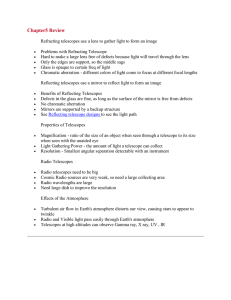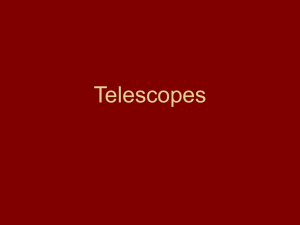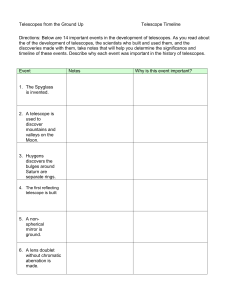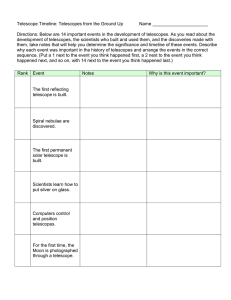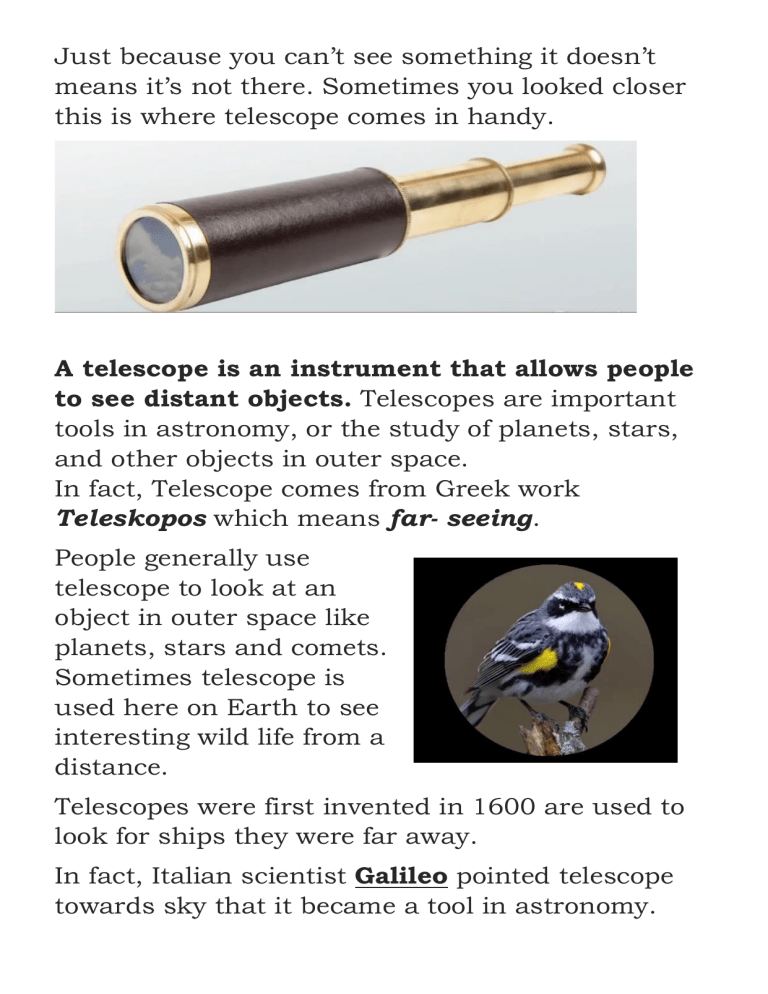
Just because you can’t see something it doesn’t means it’s not there. Sometimes you looked closer this is where telescope comes in handy. A telescope is an instrument that allows people to see distant objects. Telescopes are important tools in astronomy, or the study of planets, stars, and other objects in outer space. In fact, Telescope comes from Greek work Teleskopos which means far- seeing. People generally use telescope to look at an object in outer space like planets, stars and comets. Sometimes telescope is used here on Earth to see interesting wild life from a distance. Telescopes were first invented in 1600 are used to look for ships they were far away. In fact, Italian scientist Galileo pointed telescope towards sky that it became a tool in astronomy. Two things came out of Galileo doing this, one good and one not so good. The good thing that happened the austronomers and the scientist who studing outer space began to discover objects in space such as the moons craters,the milky way and the Jupiters moon. The bad thing that happened is that he pointed the telescope directly towards the Sun that damage his eyes. Telescopes on the sun don’t match. In the late 1600s, Isaac Newton developed the reflecting telescope. By using mirrors instead of lenses, Newton was able to make an improved telescope that did not suffer from some of the issues with the refractor. Types of Telescope: There are several different types of telescopes. Some, called light telescopes-gather light from objects. Other telescopes gather different kinds of information about the object being viewed. There are two basic types of light telescopes: refracting telescopes and reflecting telescopes. A refracting telescope uses lenses. A lens is a curved piece of glass that refracts, or bends, light. A reflecting telescope uses mirrors. Some telescopes use both lenses and mirrors. A refracting telescope is a tube with one or more lenses at each end. Light from a far-off object enters the far end of the tube. The lens or lenses at that end, called objective lenses, bend the light. They focus it at a point near the other end of the tube. The light forms an image, or picture of the object, at this point. The lens or lenses at this end, called the eyepiece, magnify the image. Reflecting telescopes are much more powerful than refracting telescopes. A reflecting telescope has a curved mirror at the bottom of the tube. Light from an object reflects, or bounces, off the mirror. The mirror focuses the light at a point in the tube. A second mirror sits in the way of this focused light. It sends the light out the side of the tube, through an eyepiece. A lens in the eyepiece magnifies the image formed by the light. In some reflecting telescopes light passes through a lens before hitting the curved mirror. The lens helps to make the image sharper. Some light telescopes are fairly small tubes that sit on a stand and can be carried around easily. Buildings called observatories house much larger, more powerful light telescopes. Spacecraft may also carry light telescopes. The Hubble Space Telescope, which orbits Earth on a spacecraft, is a type of reflecting telescope. Being outside the Earth's atmosphere allows the Hubble to view outer space without background light. This has enabled it to take some amazing pictures of far away stars and galaxies. Hubble Space Telescope was the first space-based telescope. Source: NASA. Other Telescopes Some types of telescopes do not collect light. These telescopes collect other forms of energy from space—for example, radio waves, infrared radiation (a type of heat), and X-rays. Planets, stars, gas, and other things in space give off these types of energy. Radio telescopes look like huge bowls. They collect radio waves that travel to Earth’s surface. Infrared, X-ray, and other similar telescopes are mounted on spacecraft. All these telescopes allow scientists to gather information about things in space that cannot necessarily be seen. For example, they have shown that there is water vapor in other parts of the Milky Way galaxy. They have also helped scientists understand how stars and planets form and how stars die. Fun Facts about Telescopes • • • • • The successor to the Hubble Telescope is the James Webb Space Telescope. It is planned to be launched in 2021. The first telescopes were used by sea merchants and the military. Most observatories are built on mountaintops where the air is thinner and cleaner. A lot of astronomers today work remotely from the actual telescope. They control the telescope using computers over the internet. The largest refracting telescope in the world is located at Yerkes Observatory in Wisconsin. Kitt Peak National Observatory—outside of Tucson, Arizona—is the site of the world's largest collection of optical telescopes as well as the world's largest solar telescope.
